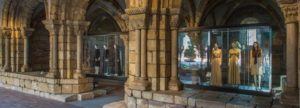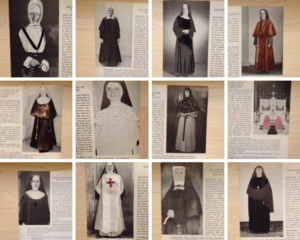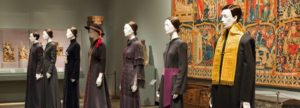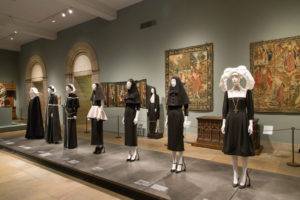Nuns and Priests
The question for this post is whether the image of nuns in popular culture prevents imagining women as priests. Or, is the image of priest so male that women cannot find a place in it? In our small faith community last week I was commenting on my experience of Rome a few years ago: nuns in habits, priests in dresses. This was the Catholic scene in the US decades and decades ago, but not today. Does Rome need a new dress code to open the priesthood?
The Heavenly Bodies exhibit at the NY Metropolitan Museum of Art includes haute couture modeled on both nuns and priests, it turns out. I finally got to see the whole exhibit, which closed last week. The soutane, the dress worn by priests in any number of black and white films, was replicated in elegant dresses, the one in the center with the hat and red trim worn by Ava Gardner in Il Pretino.
Nuns’ habits were the point of departure for other dresses using more white than the soutanes did, but still they were severe. This photo shows the wonderful integration of the exhibit into the Cloisters, worth a trip even without the dresses (but take the bus!).

At the Met itself the nuns were more fanciful.
And this was just the beginning. The excesses of the Met Gala did find inspiration in the actual exhibit; the over-the-top imaginations of some designers took my breath away with elegant simplicity or elaborate decoration. It was clear some of the dresses had been created for this exhibit; I was most interested in those like a procession of cocktail dresses with Eucharistic themes which were made years before. The premise of the exhibit, the Catholic imagination, is supported.
But I digress from nuns and priests. Another exhibit about nun’s habits just opened at the Fabric Workshop in Philadelphia: Poorly Watched Girls. I love the irony in the way the title of the larger exhibit applies to the nuns; of course, nuns were to be modest and not looked at, and therefore, the habit. Suzanne Bocanegra and others at the Workshop have elaborated pages from a 1955 book about orders of American nuns. Listing the history, ministries, qualifications, and addresses for each order, the book also attempts to describe the habits. There is a photo, usually of one nun, to which Bocanegra and the workshop embroiderers have added various decorative embellishments.

So nuns’ habits center another exhibit, as small as the Met’s was elaborate. But as I went along, I became more interested in the text than the photos. Maybe you can find it in the library of an order or one of their colleges. Even in the heyday of religious life in the United States, did orders have to advertise? Is that what this was? And why no Mercies? Not even my high school Newburgh Dominicans. Why so many orders in the first place? Should we forget our concern about the proliferation of small faith communities in our own day?
Those communities are often led by women priests. Perhaps a little book with photographs will change the popular image of nuns and priests. Oh, wait: WOC has already done that. Maybe someday someone will decorate these photos on the computer and make them into art!



2 Responses
I think we need to focus on debunking bogus theological arguments by asking reasonable questions. For example:
Is the masculinity of Jesus essential for the redemption? If so, why? Else, why is it that women cannot be ordained to act in the person of Christ?
I think women can be priests because the church has already pointed out in VAT II that the laity have a share in the priesthood and also because Jesus said that in heaven ‘there is no marrying or giving in marriage’ which puts the gender issue out of the question.